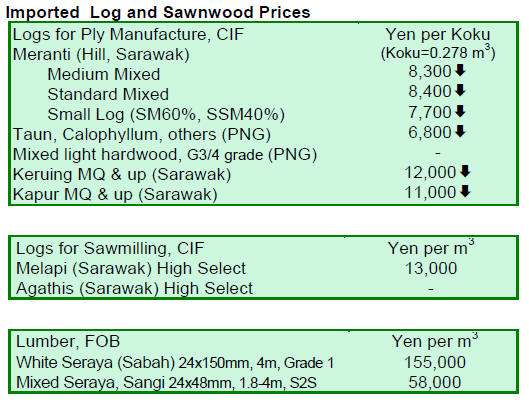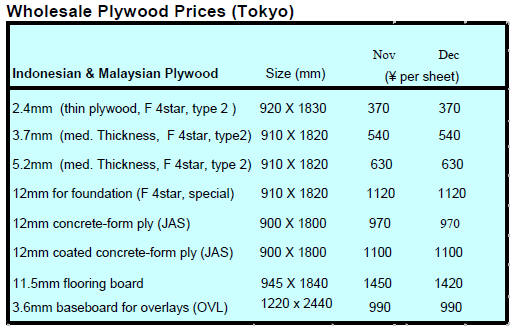Japan Wood Products
Prices
Dollar Exchange Rates of
15th December 2011
Japan Yen 77.63
Reports From Japan
Bearish sentiment in Japan caps log prices
Prices for Malaysian logs moved up marginally in
September but the underlying demand was not strong
enough to sustain them. Currently, prices remain largely
unchanged. Sentiment in the Japanese industry and in
Malaysia is bearish, says the Japan Lumber Reports (JLR).
Importers in India, big buyers of Malaysian logs, are
unable to live with the previous high prices, particularly as
the rupee has depreciated significantly and rapidly. Indian
buyers are reportedly looking for lower FOB prices. The
other major market for logs is China where buyers are
quiet.
Weak demand for super-small meranti and MLH logs
The rainy season will soon begin in Sarawak and the
question is when will it actually cause a slow down of
harvesting opeations. Normally the rain intensifies in
December but so far, says the JLR, the slight rain so far
has not hampered extraction and transportation.
Malaysian plywood mills are reportedly not chasing logs
supplies as the plywood market is dull. As a result some
log types such as super small Meranti and MLH are
moving very slowly.
Sarawak meranti regular logs for the Japanese market are
priced between US$280-300 per cu.m., unchanged in two
weeks. Some suppliers are pushing for US$330 per cu.m
but the Japanese mills find it hard to pay that much unless
the quality of the logs is extremely good.
Meranti small log FOB prices are also flat at US$260-270
per cu.m while super small log prices are US$200-230,
US$20 down from October.
The demand for tropical logs in Japan is rather limited
consequently suppliers are facing an up-hill struggle even
to maintain prices at current levels. The JLR reports that
Japanese plywood mills have ample log stocks and as
consumption is slow the mills are cautious about
committing to additional supplies.
Kitanihon Plywood abandons restoration of damaged plymill
The Kitanihon plywood factory located in Ofunato which
produced around 11,000 cu.m of plywood annually was
badly damaged by the March tsunami.
The company has now abandoned restoration efforts due
to the high cost and the risk of another tsunami since the
plant is close to the ocean. A total of 127 employees will
loose their jobs.
The subsidiary company, Ofunato Plywood, which had
been manufacturing tropical hardwood plywood, had also
stopped operation in May with the loss of 50 jobs.
Domestic forestry to get a boost from supplementary budget
A third supplementary budget was approved in late
November reports the JLR. Japan’s Forestry Agency
secured a budget of Yen 317.5 bil. far larger than the
initial budget request of Yen 270 billion. The increase is
due to a three year extension of the fund for revitalisation
of the forests.
Funds are provided to subsidise the supply of domestic
forest thinning for processing and use in the rehabilitation
of quake damaged areas. Funds are also provided for the
building of logging roads for more efficient harvesting.
The JLR says additional works to be financed from the
budget include, clarification of forest boundaries,
provision of harvesting machines, subsidies for log
extraction, assistance for construction of additional wood
processing facilities and work to dispose of biomass from
the quake hit areas.
The focus of the budget is restoration of quake damaged
areas and as such the previous emphasis on promoting
domestic wood use in public buildings and support for the
wider use of domestic timber is not emphasised in this
budget.
The JLR reports that an amount of Yen 11.2 bil. is
provided in the budget for restoration of damaged wood
processing plants.
Funds have also been allocated to investigate the extent of
radiation contamination from the damaged Fukushima
nuclear power plant and as well as for decontamination of
the forest but, as yet, there appears to be no available
technology for this.
Incentives aimed at stimulating housing demand
The budget for the Ministry of Land, Infrastructure and
Transport contains elements aimed at stimulating demand
for housing.
A range of measures have been introduced including,
making it easier for home buyers to secure a mortgage,
support for energy efficient homes and extension of the
housing ‘eco point’ system.
The ‘eco-point’ system will apply to energy saving units
and also house building in the quake damaged areas.
Accordingly, the scheme is now called ‘Restoration
support and housing eco point system’. Points are earned
by home owners when energy efficient materials and
systems are used for building houses (e.g. double glazing,
insulation and solar panels).
A budget has been provided to support local contractors
who build the so called ‘long life quality homes’. A
subsidy is will be provided for houses if more than half of
the timber used is certified.
Housing starts slipped in October as builders waited
for reintroduction of subsidies
Total starts in October were 67,273 units, 5.8% less than
the same month a year ago. This was the second lowest
level of housing starts since October 2009.
The JLR commented that house builders postponed startup
as they anticipated the incentive measures introduced in
the latest budget.
Owner units have fallen for two months and the starts for
October were the second lowest for October. Units built
for rent were the lowest for an October month. On the
other hand, condominium starts were up but were less than
9,000 units. The only sector for which starts were
unchanged was the detached built for sale homes.
In the quake damaged areas of Iwate and Fukushima
prefecture starts were down by more than 10% but starts in
Miyagi prefecture increased.


Related News:
|